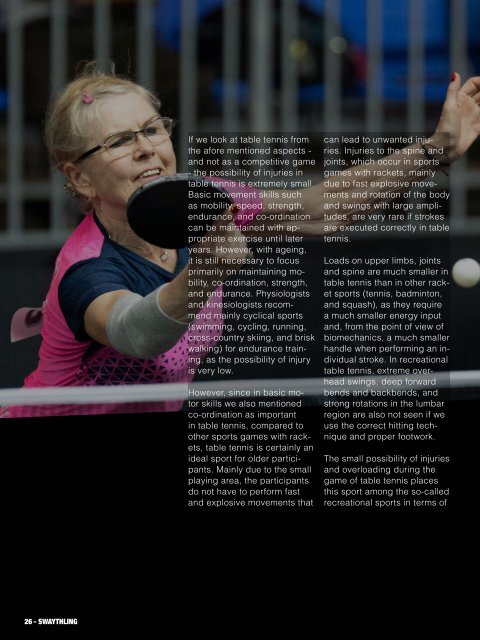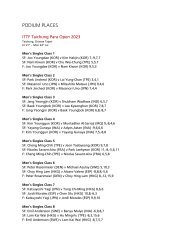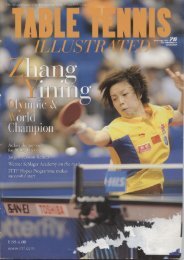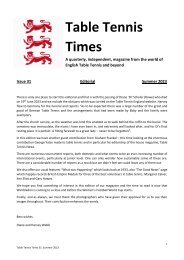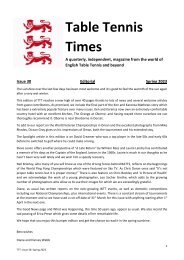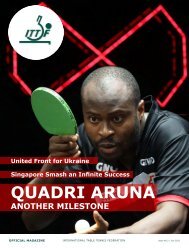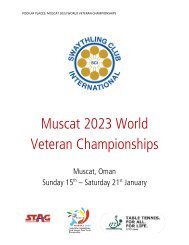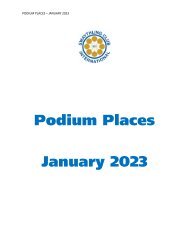Swaythling_Mag_112-1 (2023_04_26)
Create successful ePaper yourself
Turn your PDF publications into a flip-book with our unique Google optimized e-Paper software.
If we look at table tennis from<br />
the afore mentioned aspects -<br />
and not as a competitive game<br />
- the possibility of injuries in<br />
table tennis is extremely small.<br />
Basic movement skills such<br />
as mobility, speed, strength,<br />
endurance, and co-ordination<br />
can be maintained with appropriate<br />
exercise until later<br />
years. However, with ageing,<br />
it is still necessary to focus<br />
primarily on maintaining mobility,<br />
co-ordination, strength,<br />
and endurance. Physiologists<br />
and kinesiologists recommend<br />
mainly cyclical sports<br />
(swimming, cycling, running,<br />
cross-country skiing, and brisk<br />
walking) for endurance training,<br />
as the possibility of injury<br />
is very low.<br />
However, since in basic motor<br />
skills we also mentioned<br />
co-ordination as important<br />
in table tennis, compared to<br />
other sports games with rackets,<br />
table tennis is certainly an<br />
ideal sport for older participants.<br />
Mainly due to the small<br />
playing area, the participants<br />
do not have to perform fast<br />
and explosive movements that<br />
can lead to unwanted injuries.<br />
Injuries to the spine and<br />
joints, which occur in sports<br />
games with rackets, mainly<br />
due to fast explosive movements<br />
and rotation of the body<br />
and swings with large amplitudes,<br />
are very rare if strokes<br />
are executed correctly in table<br />
tennis.<br />
Loads on upper limbs, joints<br />
and spine are much smaller in<br />
table tennis than in other racket<br />
sports (tennis, badminton,<br />
and squash), as they require<br />
a much smaller energy input<br />
and, from the point of view of<br />
biomechanics, a much smaller<br />
handle when performing an individual<br />
stroke. In recreational<br />
table tennis, extreme overhead<br />
swings, deep forward<br />
bends and backbends, and<br />
strong rotations in the lumbar<br />
region are also not seen if we<br />
use the correct hitting technique<br />
and proper footwork.<br />
The small possibility of injuries<br />
and overloading during the<br />
game of table tennis places<br />
this sport among the so-called<br />
recreational sports in terms of<br />
injury prevention associated<br />
with short and less energetically<br />
demanding movements.<br />
To reduce the chances of injury<br />
and overload during senior<br />
exercise, we recommend the<br />
following - learning and perfecting<br />
the appropriate technique<br />
(depending on the age<br />
and prior knowledge of the<br />
trainee):<br />
• general and balanced exercise<br />
• suitable gymnastic exercises<br />
and stretching for relaxation of<br />
muscle tone<br />
• avoiding overloads and<br />
strenuous exercise<br />
• correct dosing of loads in<br />
the training process<br />
• a suitable base and a suitable<br />
selection of sports shoes<br />
for practising table tennis<br />
• complete rehabilitation after<br />
an injury or surgery, before<br />
starting to practise table tennis<br />
again<br />
• sports medical control after<br />
the age of 35 (preventive medical<br />
examinations).<br />
Elderly people must enjoy the<br />
game; the game itself must be<br />
at such a level that it excludes<br />
the possibility of injuries and<br />
overload to the greatest extent<br />
possible. Nevertheless, even<br />
in table tennis, it is possible<br />
to achieve results in mature<br />
years (between 30 and 45<br />
years of age). A good example<br />
of this is former world-class<br />
players like Jan-Ove Waldner,<br />
Jörgen Persson, Zoran Primorac,<br />
and others who at the<br />
age of 40 still beat players half<br />
their age.<br />
Regular training and a sporty<br />
lifestyle allowed them to constantly<br />
improve and utilise<br />
their movement skills in the<br />
game. In addition, it should be<br />
noted that with many years of<br />
practice, and thus also with<br />
age, some movements are automated<br />
and rationalised, this<br />
makes it more economical to<br />
use strength and energy in the<br />
game.<br />
Finally, club activities in table<br />
tennis. The fact is that most<br />
clubs pay too much attention<br />
to competitive table tennis<br />
whilst forgetting the other categories<br />
that allow the club<br />
to survive. Even at the level<br />
of the association, the category<br />
of older competitors is<br />
neglected, even though table<br />
tennis is considered a sport<br />
that can be played until a late<br />
age. For the most part, elderly<br />
people, who want to play table<br />
tennis, organise themselves<br />
and find suitable places and<br />
opportunities for spending<br />
their free time in a better way.<br />
All of them agree that this is<br />
their hobby and fun, but most<br />
of them are still eager to fight,<br />
compete and, of course, succeed.<br />
They say that when<br />
playing a match, a person<br />
is simply more concentrated<br />
and pays more attention to the<br />
game iself. Of course, socialising<br />
and taking care of one’s<br />
health is still the priority, which<br />
in the fast-paced social life<br />
has simply become too fast<br />
even for the elderly people;<br />
when we play table tennis,<br />
the player must feel good.<br />
Satisfaction hits made without<br />
excessive effort and regeneration<br />
after daily stress are elements<br />
in table tennis that play<br />
an important role in the quality<br />
of an individual’s free time<br />
<strong>26</strong> - SWAYTHLING SWAYTHLING - 27


